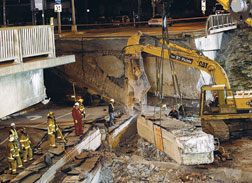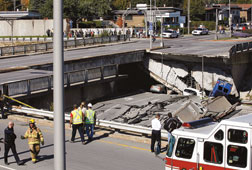 Photo:AP/Wideworld Crews begin removing pieces of concrete overpass that crushed several to death.
|
A fatal Sept. 29 collapse of a 20-meter-long section of concrete overpass in Laval, Quebec, emphasized the need to bolster the province’s—and country’s aging infrastructure, say industry officials. Lack of maintenance could be a factor in the deterioration of the 36-year-old overpass, according to one expert.
The Highway 19 overpass consisted of twin 3-lane spans. One section collapsed at about 1 p.m., killing five people in two vehicles beneath it when tons of falling concrete and steel flattened their cars. At ENR press time, at least two others buried in the rubble were thought to be dead. A province investigation was to start last week.
It was the second fatal overpass collapse in Laval, a Montreal suburb, in six years. In 2000, a new overpass under construction came to a crashing halt June 18 when four precast concrete stringers toppled off a four-span bridge (ENR 6/26/00 p. 11). That accident killed one person and injured two others.
Immediately following the collapse, Quebec Transport Minister Michel Després ordered a twin overpass just north of the site to be shut down. It is of the same age and built by the same contractor, according to published reports. ENR could not confirm details of the collapsed structure by press time.
| The accident is a wake-up call on Canada’s infrastructure, says a construction association spokesman. |
Ministry engineers inspected 18 similarly designed bridges throughout the province. Preliminary results indicate they are structurally safe, says ministry spokesperson Jean-Francoise Racine.
The six-lane Highway 19, under provincial jurisdiction, is one of three highways that connect suburban Laval with Montreal, to the south. Després confirmed that a ministry official had conducted a visual and auditory inspection just a few hours before the collapse, after police had alerted his department to concrete that fell on the highway. The official had said the bridge was not in immediate danger. More concrete fell after the inspection. Then the collapse occurred.
 Photo:AP/Wideworld Some believe that lack of proper maintenance led to fatal collapse.
|
A thorough 2005 inspection of the 36-year-old overpass, known as Blvd. de la Concorde, did not reveal any problems. Racine says he cannot comment on the nature or scope of the inquiry. “We can’t comment until the inquiry is over,” says Katia Reyburn, spokesperson for the bridge designer, Montreal-based Dessau-Soprin Inc. “But we will certainly be offering our assistance to the inquiry.”
The overpass will be closely studied and inspected by teams of ministry structural engineers to determine if it can provide any clues. The results will help determine how and when to conduct repairs. “It will be a priority,” says Racine.
But University of Toronto civil engineering professor and concrete structure specialist Shamim Sheikh says a new bridge may be required. He believes that steel rebar may have separated from the concrete of the overpass, a box structure with some prestressing. “Several factors could have caused the collapse if we assume there were no design or construction flaws,” says Sheikh.
Salt is used extensively in Quebec to melt ice on highways during its harsh winters. But salt can cause corrosion of the steel, which leads to spalling of the concrete. Highways are also vulnerable to frequent freezing-thawing cycles, which weakens the concrete, says Sheikh. “All of these factors, not discounting construction and material failures, could have been a cause,” he says.
That the preliminary inspection of the overpass—just before the accident— found nothing wrong underscores the need for more in-depth and regular inspection of some 50,000 bridges throughout Canada, he adds. “We don’t spend enough money on inspection,” says Sheikh.
There are some 2,800 provincially owned bridges in Ontario. Ministry officials claim these bridges are monitored regularly through drive-by visual inspections plus annual and biannual visual inspections by professional engineers.
Canadian Construction Association spokesperson Jeff Morrison says the group cannot comment specifically on the collapse. But it is a “wake-up call” to all government officials to address the issue of Canada’s “seriously deteriorating infrastructure,” he says.
In May, the new Conservative government announced it would proceed with an election campaign promise to create a $2.15-billion Highways and Borders Infrastructure Fund program. Laval Mayor Gilles Vaillancourt says he has told the Quebec government it needs to spend $1.79 billion a year for 15 years to improve deteriorating infrastructure.


Post a comment to this article
Report Abusive Comment